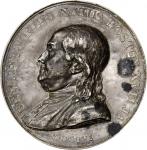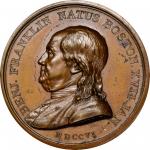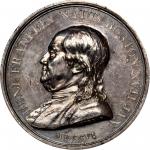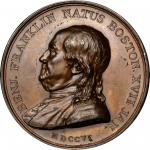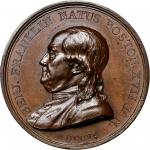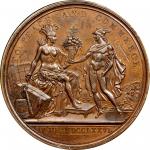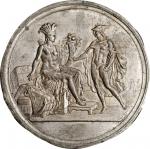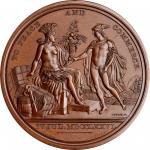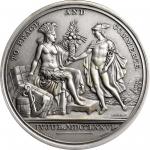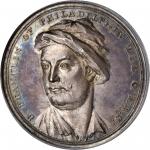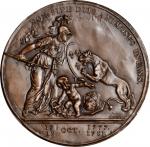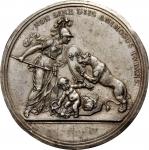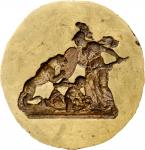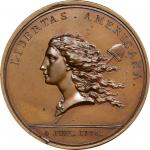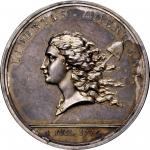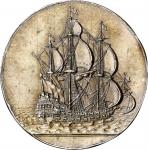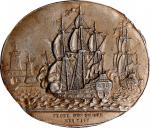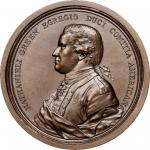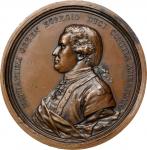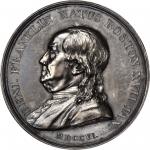1784 Franklin Winged Genius medal. Betts-619. Silver. Original dies. Paris Mint. 46.0 mm. 693.0 grains. 3.3 - 4.0 mm thick. Choice About Uncirculated.Plain concave edge. Deep antique gray and navy blue with highlights of gold and pastel blue on both sides. The fields on both sides are lustrous and lightly reflective, though scattered light marks and evidence of handling are seen. A long arc scratch curves from the lightning bolt across the lightning rod atop the temple at the left side of the reverse, and a curlicue scratch in the right reverse field is noted parallel to the Genius lower hand. A cut on the edge, invisible from either side, is noted near 10:00 relative to the obverse.<p>The reverse appears a bit wavy and swollen at its center, an issue that befell this die when it hardened and later metastasized into a crack that ended this reverses life rather prematurely. The die was replaced with the reverse that encloses the same legend in a wreath, then at some later date another Winged Genius reverse die was made with slightly different lettering. This original reverse die shows the U in FULMEN rendered correctly (with the thicker side to the left) and the exergue shows the L of MDCCLXXXIV lined up directly beneath P of DUPRE. On the later copy Winged Genius reverse, the U of FULMEN is punched with its thicker side to the right, and the L of the date is lined up beneath U of DUPRE.<p>The obverse of this medal is singularly fascinating. The obverse was initially created with an error date. Rather than MDCCXVI for Franklins year of birth (1706), it was punched with MDCCXV. This medal must have been struck extremely early in the dies life, as it was coined before the obverse die was corrected - instead, an incuse I is punched over the round stop that followed MDCCXV and another incuse period was punched after it. On all other medals using the original Winged Genius reverse, including the bronze strikings in Ford and LaRiviere and the obverse cliches included in this collection and LaRivieres, the die has been corrected. If its silver composition wasnt enough to make this medal very special, it is also unique in this uncorrected first state form.<p>Adams and Bentley cite this piece as the only silver specimen known to them. It is entirely unique with the incuse date correction, but the American Philosophical Society holds an original reverse Winged Genius medal in silver struck from the corrected obverse and this same original reverse die. A silver specimen of this medal was offered in New York Coin and Stamps sale of May 1892, lot 338, but the description is not enough to discern whether the reverse was the original die (or even if this was a plain edge piece from the pre-1842 era or a later restrike with a Paris Mint edge marking). Considering when Godfrey A.S. Weiners, a famous New York publisher, was active collecting, there is a chance that the 1892 offering was actually this piece. Bronze pieces from the original reverse die are not appreciably more common: Ford and LaRiviere each had one, and another was sold in our August 2013 ANA sale as lot 1010. Zigrosser ("Medallic Sketches of Augustin Dupre in American Collections," published by the American Philosophical Society in 1957) illustrates a bronze specimen in the APS Collection that appears to be from the original reverse and the corrected original obverse. Perhaps three cliches are known of the original reverse, including one in the Massachusetts Historical Society, the LaRiviere cliche, and one in the present offering. Thus, this original reverse is fully Rarity-7 in all compositions combined. In this one, it is utterly unique.<p>This medal has been readily adopted into the Comitia Americana series, even though its more common cognate, Betts-620 with the wreath and inscription reverse, is the medal Jefferson chose to include in George Washingtons set of silver strikes. Given the rarity of this medal today, it seems likely that once the dies failed, it was impossible for Jefferson to get his hands on one of this type by 1789 and he instead settled for what was then available.<p>The relative availability of Betts-620 has made collectors underestimate the rarity and importance of Betts-619. This design is rare in any form, even from the later copy reverse. In this form, from Dupres original reverse die, it is practically non-collectible in any composition, with fewer than a half dozen in private hands. In silver, its rarity is literally unsurpassable.<p><strong>Benjamin Franklin Natus Boston</strong><p>The exact circumstances that led up to Augustin Dupre creating a medal to honor Benjamin Franklin are unclear. There is little paper trail emanating from either of these gentleman, artist or subject, to indicate that a special anniversary or incident was being celebrated. Rather, this seems to be what has long been termed a "personal medal," that is, a medal to honor a figure whose character was admired by the artist who created it.<p>Sketches in the collections of the American Philosophical Society and Boston Public Library, as well as three retained in the Dupre estate, show the evolution of Dupres design concept for the reverse of this medal. Several drawings depict a fully grown Hercules - a play on the infant Hercules who represents America on the Libertas Americana medal - trampling two figures, one of whom wears a crown and holds a broken scepter. Eventually Dupre came upon versions of the Winged Genius design that were close to the adopted motif. The legend ERIPUIT COELO FULMEN SCEPTRUMQUE TYRANNIS, commonly translated as "He snatched lightning from the heavens and the scepter from tyrants," is typically attributed to Turgot, the French politician and economist. It first appeared on a print of Franklin dated 1778, and various versions of the phrase floated around France thereafter. The legend is found on one of Ninis large size Franklin portraits in terracotta, dated 1779, and its often found hand-inscribed on the back of the smaller and more commonplace 1777 Nini Franklin portraits as well.<p>Franklin said little about this medal, which may suggest that he heard little about it - the Betts-619 from original dies is rare enough today to suggest that very few of them were struck during Franklins lifetime. Indeed, by the time Franklin left his French home at Passy for good on July 12, 1785, Dupres celebratory medal was probably still a fairly well kept secret. His friend E.A. Gibelin, who helped design the reverse of the Libertas Americana medal, wrote him on February 7, 1785, on various topics and noted "M. Dupre le graveur men a montre une avec linscription eripuit coelo fulmen etc." or "Mr. Dupre the engraver showed me one with the inscription eripuit coelo fulmen etc." No other mention of this medal appears in Franklins papers, save a handbill advertising the Comte dEstaings 1790 work entitled "Appercu Hazarde Sur LExportation Dans Les Colonies," which was dedicated to Franklin and illustrated the Winged Genius medal on its title page.<p>As beautiful as Dupres first effort was, it was short lived and has proved a major rarity today. The reason the second medal, Betts-620, supplanted the first is clear from studying the medals: the initial reverse failed and was, unfortunately, replaced with a far less imaginative one. This second type was all that was available when Jefferson built the small collection to present to President George Washington, now conserved at the Massachusetts Historical Society. Sometime after Franklins death, the first reverse design was brought back again with a new copy die; as popular as Franklin was in life, he became perhaps more so in death. The original obverse die and the original replacement die (with wreath) also lived on for generations of restrikes. After 1842, these restrikes were marked on the edge with Paris Mint privy marks. They remain accessible enough to suggest that they were popular sellers throughout the 19th century in France and abroad.<p><strong>The Benj. Franklin Natus Boston Medal:</strong><p><strong>Obverse:</strong> Franklins profile faces left, based on the portrait bust by Houdon, with DUPRE F. on the shoulder truncation. The date MDCCVI beneath the bust represents the year of his birth, 1706. The legend BENJ. FRANKLIN NATUS BOSTON XVII JAN around the periphery completes the thought: "Benjamin Franklin born at Boston, January 17."<p><strong>First Reverse:</strong> A winged genius, symbolizing brilliance of thought, stands at center with one hand raised to the thunderbolt behind him. A lightning rod, invented by Franklin, attracts the bolt atop a temple at left. A broken scepter and crown lay on the ground at right. The peripheral legend ERIPUIT COELO FULMEN SCEPTRUMQUE TYRANNIS, or "He snatched lightning from the heavens and the scepter from tyrants," is perhaps the most famous aphorism about Franklin. In the exergue, Dupre takes full credit: SCULPSIT ET DICAVIT / AUG. DUPRE ANNO / MDCCLXXXIV or "Engraved and dedicated by Augustin Dupre in the year 1784."<p><strong>Second Reverse:</strong> A simple oak wreath contains the legend ERIPUIT COELO FULMEN SCEPTRUMQUE TYRANNIS. Below the wreath, the legend continues in three lines: SCULPSIT ET DICAVIT / AUG. DUPRE ANNO / MDCCLXXXVI<p><p><p><p><p><p><p>From the John W. Adams Collection. Acquired from our sale of the John J. Ford, Jr. Collection, Part XIV, May 2006, lot 345. Earlier, from Sotheby Parke-Bernet’s sale of the Godfrey A.S. Wieners Collection, October 25, 1960.

